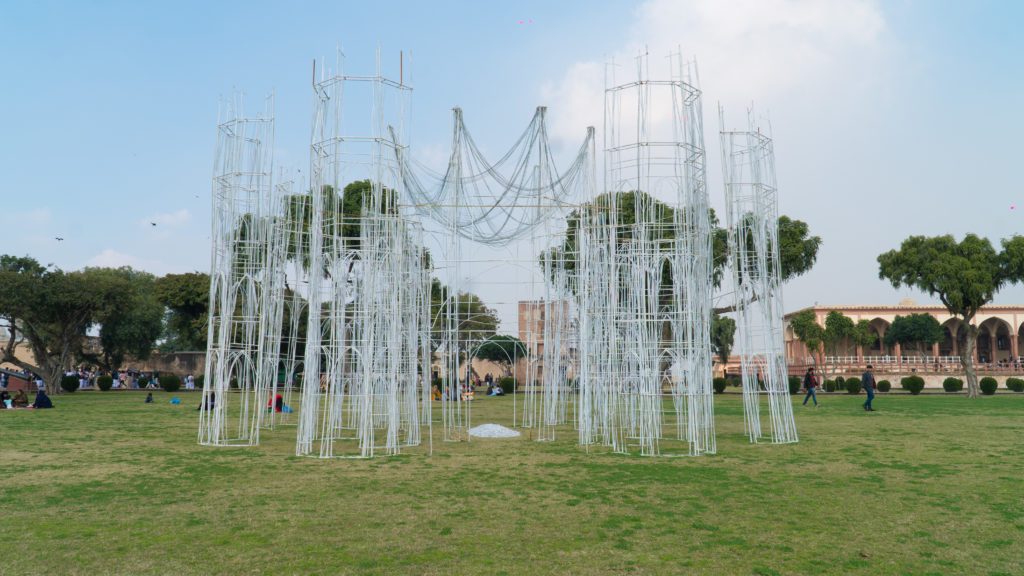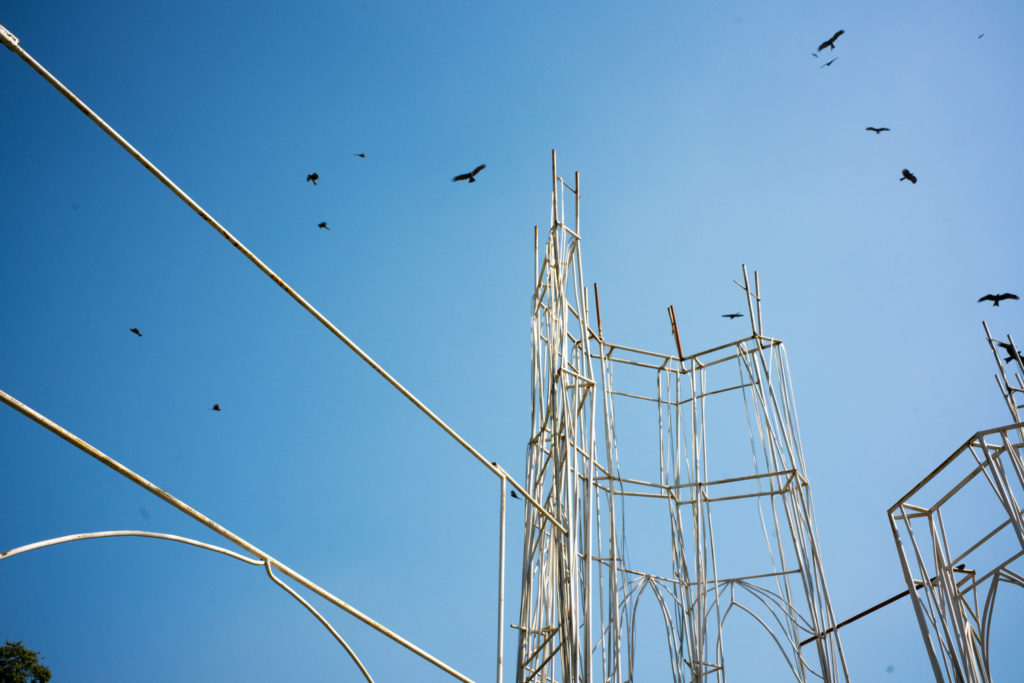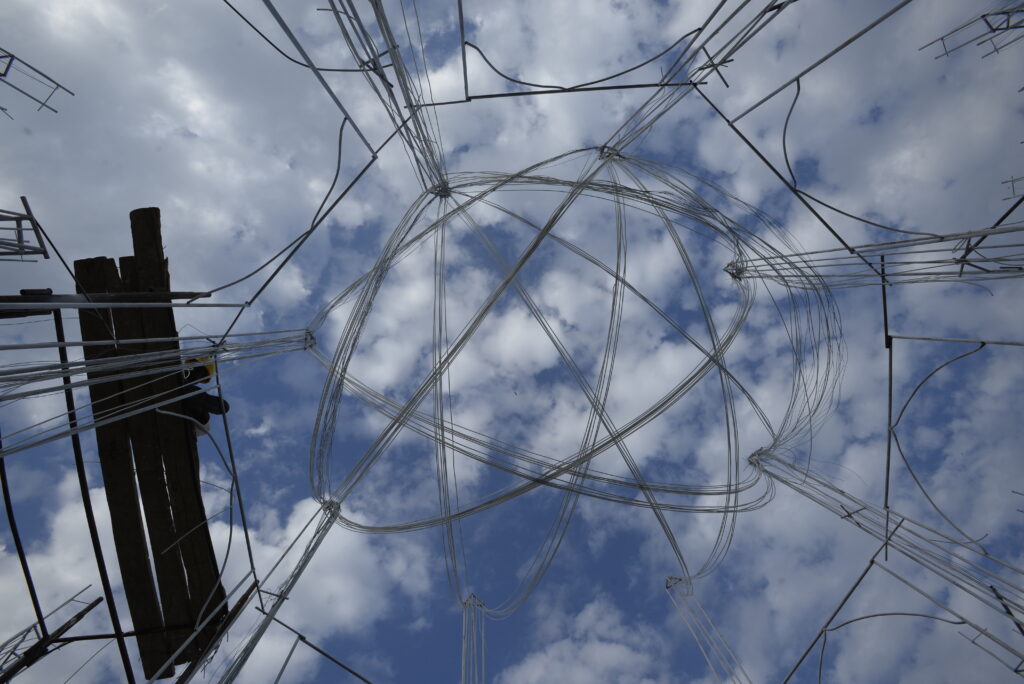Diana Al-Hadid
The Escape of Anarkali, 2019 – 2020
Site-specific sculptural intervention, new commission
‘On my research trip to Lahore, I learned about the story of Anarkali. According to legend, Anarkali had an affair with the crown prince against the wishes of Mughal Emperor Akbar, who ordered her be buried alive between walls. Today the Tomb of Anarkali, which was built over the site of her immurement by the prince turned emperor in her honor, is used as the Punjab Archives. An empty sarcophagus sits there today, and while her body is not present, her story in effect guards the country’s historic records. Some speculate that this possibly fictitious story was told by colonialists to demonstrate that they were significantly less ruthless than their Mughal predecessors.
I am interested in stories about or by women. Particularly when those stories reveal so much about the usually male – or in this case possibly colonialist- authors and the surrounding cultural context. Curiously, I have been making work for several years about “Gradiva”— another ficitional female character that is partially buried in a wall in thhe form of a relief sculpture, but in her case she is born from the wall, unlike Anarkali who dies within one. I am deeply interested in sites that draw forward the legends or memories of a long dead person whose remains are not present, such that the building or tomb itself becomes a stand-in for a body. This merging of figure and architecture has been a foundational premise for many of my works, such that sometimes a building displaced reads a figure displaced.’ Diana Al-Hadid
ڈ یا نا الحد ید
اپنے لاہور کے تحقیقی دورے کے دوران َمیں نے انارکلی کی کہانی کے بارے میں جانا۔ روایت کے مطابق، انارکلی کا شہزادے کے ساتھ معاشقہ چل رہا تھا جس کا مغل بادشاہ اکبر مخالف تھا۔ اکبر نے اسے دیواروں میں چنوانے کا حکم دیا۔ آج انارکلی کا مقبرہ، جسے شہزادے نے، جو بعد میں بادشاہ بن گیا، نے انارکلی کی یاد میں، اسے دیواروں میں قید کیے جانے کے مقام پرتعمیر کرایا تھا، پنجاب کے دستاویزی ریکارڈ کے دفتر کے طور پر استعمال ہوتا ہے۔ وہاں ایک خالی قبر موجود ہے، اور اگرچہ اس کا جسم وہاں موجود نہیں ہے، اس کی ممکنہ افسانوی داستان درحقیقت ملک کے تاریخی ریکارڈ کا تحفظ کرتی ہے۔ کچھ لوگ ظاہر کرتے ہیں کہ یہ کہانی استعماریوں کی گھڑی ہوئی تھی تاکہ وہ یہ ثابت کرسکیں کہ وہ مغل حکمرانوں سے کہیں زیادہ کم سنگدل تھے
میں خواتین سے متعلق یا ان کی سنائی گئی ِکہانیوں میں دلچسپی رکھتی ہوں۔ خاص طور پر اس وقت جب یہ کہانیاں عمومی طور پر مرد- یا اس صورت میں ممکنہ طور پر استعماری- مصنفین اور مذکور ثقافتی پس منظر کے بارے میں بہت کچھ بیان کرتی ہوں۔ حیرت انگیز طور پر، میں کئی سالوں تک ایک عورت “گرادیوا” پر کام کرتی رہی ہوں۔ جو انارکلی کے برعکس، ایک افسانوی شخصیت ہے جو دیواروں میں چلتی ہے۔گرادیوا بنیادی طور پر دیوار میں سے پیدا ہوئی تھی کیونکہ وہ دیوار میں کھدا ہوا ایک مجسمہ تھا۔ میں نےیادگاری قبروں پر بھی کام کیا ہے اور میں ان مقامات میں گہری دلچسپی لیتی رہی ہوں جولوک داستانوں یا طویل عرصہ قبل وفات پا جانے والی شخصایت کی یادوں کو منظر عام پر لاتے ہیں، اس طرح سے کہ وہ عمارت یا مقبرہ کسی شخص کامتبادل بن جائے۔شخصیت یافِن تعمیریایہ انضمام میرےزیادہ ترکام کی بنیادرہاہے،اسطرح سے کہ بعض اوقات ایک بے دخل شدہ عمارت کسی بے دخل شدہ شخصیت کا متبادل بن جائے- ڈ یا نا الحد ید
Co-Commissioned by: Ndure SSC Brand, FAST Cable, Agha Steel, Rafae bin Khalid & the Lahore Biennale Foundation
Text provided by the artist
Artist Assistant: Ali Baba






